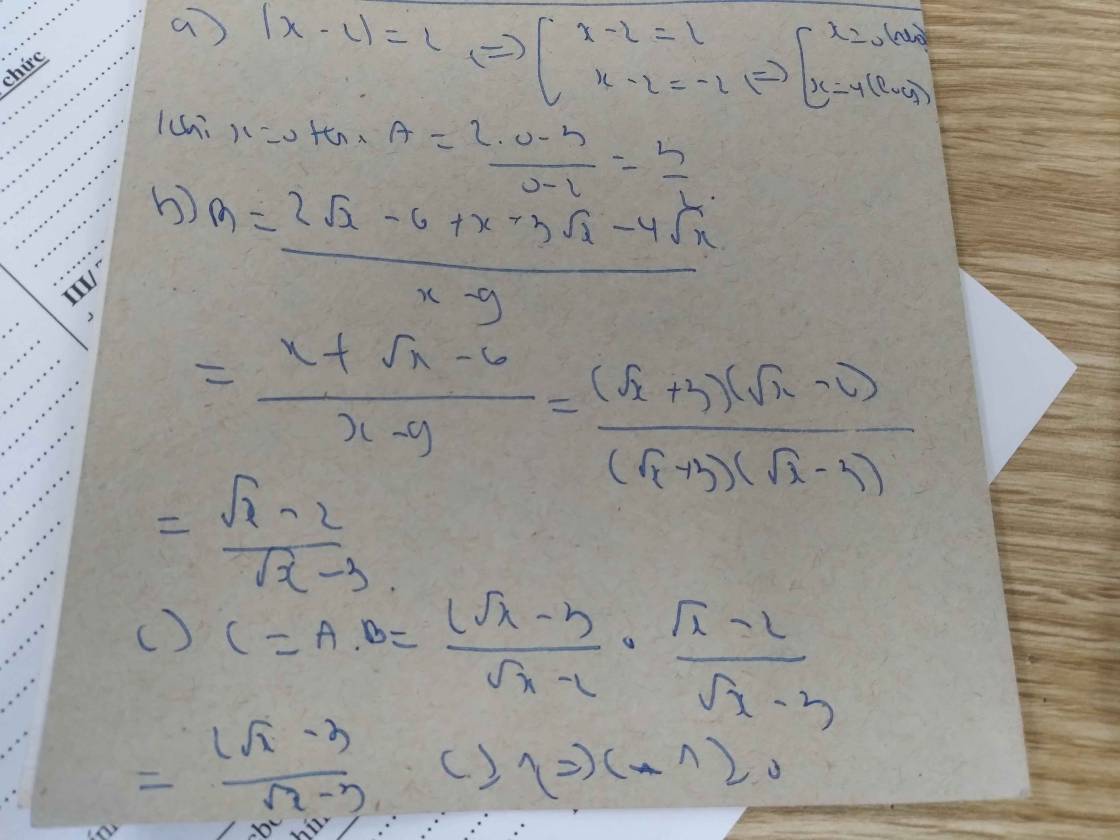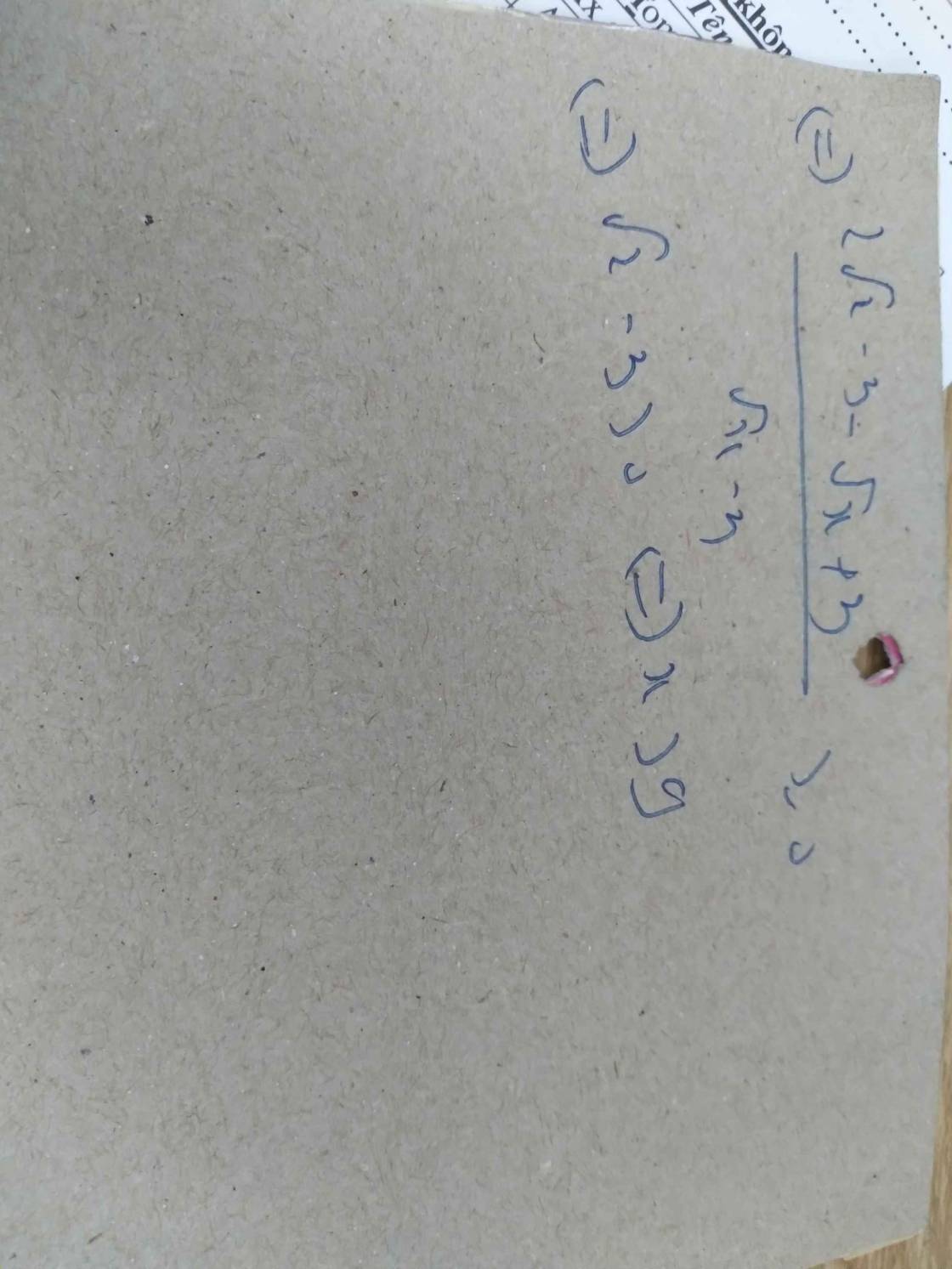Hãy nhập câu hỏi của bạn vào đây, nếu là tài khoản VIP, bạn sẽ được ưu tiên trả lời.

`a)|x-2|=2<=>[(x=4(ko t//m)),(x=0(t//m)):}`
Thay `x=0` vào `A` có: `A=[2\sqrt{0}-3]/[\sqrt{0}-2]=3/2`
`b)` Với `x >= 0,x ne 4` có:
`B=[2(\sqrt{x}-3)+\sqrt{x}(\sqrt{x}+3)-4\sqrt{x}]/[(\sqrt{x}+3)(\sqrt{x}-3)]`
`B=[2\sqrt{x}-6+x+3\sqrt{x}-4\sqrt{x}]/[(\sqrt{x}+3)(\sqrt{x}-3)]`
`B=[x+\sqrt{x}-6]/[(\sqrt{x}+3)(\sqrt{x}-3)]`
`B=[(\sqrt{x}+3)(\sqrt{x}-2)]/[(\sqrt{x}+3)(\sqrt{x}-3)]`
`B=[\sqrt{x}-2]/[\sqrt{x}-3]`
`c)` Với `x >= 0,x ne 4` có:
`C=A.B=[2\sqrt{x}-3]/[\sqrt{x}-2].[\sqrt{x}-2]/[\sqrt{x}-3]=[2\sqrt{x}-3]/[\sqrt{x}-3]`
Có: `C >= 1`
`<=>[2\sqrt{x}-3]/[\sqrt{x}-3] >= 1`
`<=>[2\sqrt{x}-3-\sqrt{x}+3]/[\sqrt{x}-3] >= 0`
`<=>[\sqrt{x}]/[\sqrt{x}-3] >= 0`
Vì `x >= 0=>\sqrt{x} >= 0`
`=>\sqrt{x}-3 > 0`
`<=>x > 9` (t/m đk)

a: \(A=\dfrac{x-3\sqrt{x}+2x+6\sqrt{x}-3x-9}{x-9}=\dfrac{-3\sqrt{x}-9}{x-9}\)
\(=\dfrac{-3\left(\sqrt{x}+3\right)}{\left(\sqrt{x}-3\right)\left(\sqrt{x}+3\right)}=\dfrac{-3}{\sqrt{x}-3}\)
b: A=1/3
=>\(\dfrac{-3}{\sqrt{x}-3}=\dfrac{1}{3}\)
=>căn x-3=-9
=>căn x=-6(loại)
c: căn x-3>=-3
=>3/căn x-3<=-1
=>-3/căn x-3>=1
Dấu = xảy ra khi x=0

a, Thay x = 25, ta tính được A = 10 7
b, Rút gọn được B =
2
x
-
3
c, Ta có A.B =
2
-
4
x
+
2
![]() =>
2
+
2
∈
Ư
4
. Từ đó tìm được x = 0, x = 4
=>
2
+
2
∈
Ư
4
. Từ đó tìm được x = 0, x = 4

Câu 2:
a,
diện tích nhựa là: 2π. (0,4:2). 16= 6,4π (cm2)
b,
gọi chữ số hàng chục là a (a>0, a ∈N)
hàng đơn vị là b (b∈N)
hiệu 2 chữ số là: a-b=3 (1)
tổng bình phương 2 chữ số là: a2+b2=45 (2)
từ (1) và (2) ta có hpt:
\(\left\{{}\begin{matrix}a-b=3\\a^2+b^2=45\end{matrix}\right.\)
=> \(\left\{{}\begin{matrix}a=6\\b=3\end{matrix}\right.\)
vậy chữ số đó là 63
Câu 1
a, Thay x=25 vào biểu thức B ta có
B=\(\dfrac{\sqrt{25}-3}{\sqrt{25}-1}=\dfrac{5-3}{5-1}=\dfrac{2}{4}=\dfrac{1}{2}\)
b, Ta có M=\(A\cdot B\)
⇒\(\left(\dfrac{2\sqrt{x}}{\sqrt{x}+3}+\dfrac{\sqrt{x}}{\sqrt{x}-3}\right)\cdot\dfrac{\sqrt{x}-3}{\sqrt{x}-1}\)
=\(\dfrac{2\sqrt{x}\left(\sqrt{x}-3\right)+\sqrt{x}\left(\sqrt{x}+3\right)}{\left(\sqrt{x}-3\right)\left(\sqrt{x}+3\right)}\cdot\dfrac{\sqrt{x}-3}{\sqrt{x}-1}\)
=\(\dfrac{3x-3\sqrt{x}}{\left(\sqrt{x}+3\right)}\cdot\dfrac{1}{\sqrt{x}-1}\)
=\(\dfrac{3\sqrt{x}\left(\sqrt{x}-1\right)}{\left(\sqrt{x}+3\right)\left(\sqrt{x}-1\right)}\)
=\(\dfrac{3\sqrt{x}}{\sqrt{x}+3}\)
c, Để M<\(\sqrt{M}\)
Thì\(\text{}\text{}\text{}\text{}\dfrac{3\sqrt{x}}{\sqrt{x}+3}< \sqrt{\dfrac{3\sqrt{x}}{\sqrt{x}+3}}\)
⇔\(\text{}\text{}\text{}\text{}\dfrac{3\sqrt{x}}{\sqrt{x}+3}< \dfrac{\sqrt{3\sqrt{x}\left(\sqrt{x}+3\right)}}{\sqrt{x}+3}\)
⇔\(\text{}\text{}\text{}\text{}3\sqrt{x}< \sqrt{3\sqrt{x}\left(\sqrt{x}+3\right)}\)
⇔\(\text{}\text{}\text{}\text{}9x< 3\sqrt{x}\left(\sqrt{x}+3\right)\)
⇔\(\text{}\text{}\text{}\text{}3\sqrt{x}< \sqrt{x}+3\)
⇔\(\text{}\text{}\text{}\text{}2\sqrt{x}< 3\)
⇔\(\text{}\text{}\text{}\text{}\sqrt{x}< \dfrac{3}{2}\)
⇒\(\left\{{}\begin{matrix}x\ge0\\x< \dfrac{9}{4}\end{matrix}\right.\)
⇒\(0\le x< \dfrac{9}{4}\)

Câu 1:
ĐKXĐ: \(\left\{{}\begin{matrix}x\ge0\\x\ne9\end{matrix}\right.\)
a) Thay x=16 vào B, ta được:
\(B=\dfrac{1}{\sqrt{16}-3}=\dfrac{1}{4-3}=1\)
Vậy: Khi x=16 thì B=1
b) Ta có: M=A-B
\(=\dfrac{x+3}{x-9}+\dfrac{2}{\sqrt{x}+3}-\dfrac{1}{\sqrt{x}-3}\)
\(=\dfrac{x+3}{\left(\sqrt{x}-3\right)\left(\sqrt{x}+3\right)}+\dfrac{2\left(\sqrt{x}-3\right)}{\left(\sqrt{x}+3\right)\left(\sqrt{x}-3\right)}-\dfrac{\sqrt{x}+3}{\left(\sqrt{x}-3\right)\left(\sqrt{x}+3\right)}\)
\(=\dfrac{x+3+2\sqrt{x}-6-\sqrt{x}-3}{\left(\sqrt{x}+3\right)\left(\sqrt{x}-3\right)}\)
\(=\dfrac{x+\sqrt{x}-6}{\left(\sqrt{x}+3\right)\left(\sqrt{x}-3\right)}\)
\(=\dfrac{x+3\sqrt{x}-2\sqrt{x}-6}{\left(\sqrt{x}+3\right)\left(\sqrt{x}-3\right)}\)
\(=\dfrac{\sqrt{x}\left(\sqrt{x}+3\right)-2\left(\sqrt{x}+3\right)}{\left(\sqrt{x}+3\right)\left(\sqrt{x}-3\right)}\)
\(=\dfrac{\left(\sqrt{x}+3\right)\left(\sqrt{x}-2\right)}{\left(\sqrt{x}+3\right)\left(\sqrt{x}-3\right)}\)
\(=\dfrac{\sqrt{x}-2}{\sqrt{x}-3}\)
c) Để \(M=\dfrac{\sqrt{x}+1}{\sqrt{x}+2}\) thì \(\dfrac{\sqrt{x}-2}{\sqrt{x}-3}=\dfrac{\sqrt{x}+1}{\sqrt{x}+2}\)
\(\Leftrightarrow\left(\sqrt{x}-2\right)\left(\sqrt{x}+2\right)=\left(\sqrt{x}-3\right)\left(\sqrt{x}+1\right)\)
\(\Leftrightarrow x-4=x-2\sqrt{x}-3\)
\(\Leftrightarrow-2\sqrt{x}-3=-4\)
\(\Leftrightarrow-2\sqrt{x}=-1\)
\(\Leftrightarrow\sqrt{x}=\dfrac{1}{2}\)
hay \(x=\dfrac{1}{4}\)(thỏa ĐK)
Vậy: Để \(M=\dfrac{\sqrt{x}+1}{\sqrt{x}+2}\) thì \(x=\dfrac{1}{4}\)
Câu 2:
b) Gọi thời gian tổ 1 hoàn thành công việc khi làm một mình là x(giờ)
thời gian tổ 2 hoàn thành công việc khi làm một mình là y(giờ)
(Điều kiện: x>12; y>12)
Trong 1 giờ, tổ 1 làm được: \(\dfrac{1}{x}\)(công việc)
Trong 1 giờ, tổ 2 làm được: \(\dfrac{1}{y}\)(công việc)
Trong 1 giờ, hai tổ làm được: \(\dfrac{1}{12}\)(công việc)
Do đó, ta có phương trình: \(\dfrac{1}{x}+\dfrac{1}{y}=\dfrac{1}{12}\)(1)
Vì khi tổ 1 làm trong 2 giờ, tổ 2 làm trong 7 giờ thì hai tổ hoàn thành được một nửa công việc nên ta có phương trình: \(\dfrac{2}{x}+\dfrac{7}{y}=\dfrac{1}{2}\)(2)
Từ (1) và (2) ta lập được hệ phương trình:
\(\left\{{}\begin{matrix}\dfrac{1}{x}+\dfrac{1}{y}=\dfrac{1}{12}\\\dfrac{2}{x}+\dfrac{7}{y}=\dfrac{1}{2}\end{matrix}\right.\Leftrightarrow\left\{{}\begin{matrix}\dfrac{2}{x}+\dfrac{2}{y}=\dfrac{1}{6}\\\dfrac{2}{x}+\dfrac{7}{y}=\dfrac{1}{2}\end{matrix}\right.\)
\(\Leftrightarrow\left\{{}\begin{matrix}\dfrac{-5}{y}=\dfrac{-1}{3}\\\dfrac{1}{x}+\dfrac{1}{y}=\dfrac{1}{12}\end{matrix}\right.\Leftrightarrow\left\{{}\begin{matrix}y=15\\\dfrac{1}{x}+\dfrac{1}{15}=\dfrac{1}{12}\end{matrix}\right.\)
\(\Leftrightarrow\left\{{}\begin{matrix}\dfrac{1}{x}=\dfrac{1}{60}\\y=15\end{matrix}\right.\Leftrightarrow\left\{{}\begin{matrix}x=60\\y=15\end{matrix}\right.\)(thỏa ĐK)
Vậy: Tổ 1 cần 60 giờ để hoàn thành công việc khi làm một mình
Tổ 2 cần 15 giờ để hoàn thành công việc khi làm một mình




a: \(C=\dfrac{c+6\sqrt{c}+9-c+6\sqrt{c}-9}{\left(\sqrt{c}-3\right)\left(\sqrt{c}+3\right)}\cdot\dfrac{\sqrt{c}-3}{\sqrt{c}}\)
\(=\dfrac{12}{\sqrt{c}+3}\)
b: C nguyên khi \(\sqrt{c}+3\in\left\{3;4;6;12\right\}\)
=>c=1 hoặc c=81